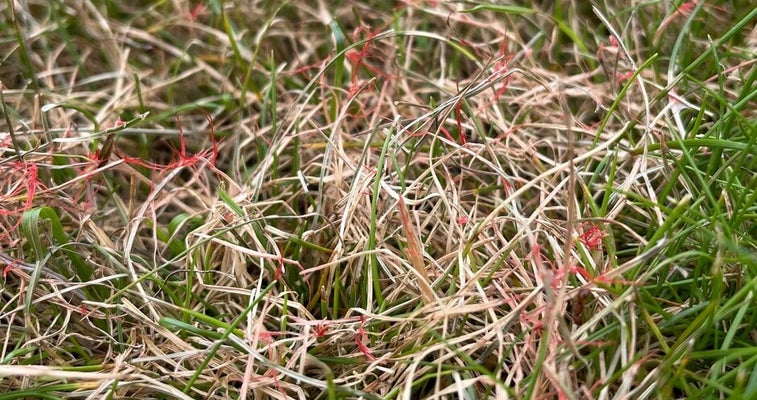
Quick facts
Common name - Red thread
Scientific name - Laetisaria fuciformis
Plants affected - Turf grasses
Main symptoms - Brown patches with red, thread-like fungal growth
Caused by - Fungus
Timing - All year, but more common in autumn
What is red thread?
Red thread is a common cause of patches of dead grass on lawns during wet summers and in autumn. It is caused by the fungus Laetisaria fuciformis. Red thread will rarely kill the grass completely, and the patches will recover with appropriate remedial action. The disease can develop at any time of year, but is most common in late summer and autumn.
It is most serious on red fescue (Festuca rubra), but other fescues, bents (Agrostis spp.), ryegrass (Lolium perenne) and annual meadow grass (Poa annua) are also attacked.
Symptoms
You may see the following symptoms:
- Patches of affected grass with a reddish tinge at first, later becoming light brown or almost bleached in appearance
- Patches usually vary in size from 7.5cm (3in) to 25cm (10in) in diameter, but can be much larger
Two types of fungal growth may be seen on the patches, particularly under wet or humid conditions. Both are visible to the naked eye, but are seen better with a hand lens or magnifying glass.
- The first takes the form of small, pink, cottony flocks, and can be confused with growth of the fungus causing snow mould
- The second is specific to red thread, and gives the disease its common name. Pinkish-red, gelatinous, thread-like structures (stromata), 1-2mm (less than ¼in) in length, are produced on the leaves and may bind them together

Control
The RHS believes that avoiding pests, diseases and weeds by good practice in cultivation methods, selection, and encouraging or introducing natural enemies, should be the first line of control. If chemical controls are used, they should be used only in a minimal and highly targeted manner.
Non-chemical control
If red thread appears, application of nitrogen to the affected area will often be sufficient to control it. Nitrogen is best given as sulphate of ammonia at 15g per sq m (½oz per sq yd). Do not apply after August to avoid the production of soft growth which is prone to snow mould.
The threat from red thread can be reduced by taking action to improve the drainage and aeration of the turf. Scarifying the turf with a lawn rake or electric scarifier will remove thatch and moss and increase aeration. Poor drainage and compacted areas can be alleviated by forking or by the use of a solid-tine or hollow-tine aerator. Ensure that the soil is not deficient in nitrogen. Disposing of (not ) grass clippings will reduce the amount of fungus present to re-infect the lawn.
Chemical control
There are no fungicides currently available to home gardeners for the control of lawn diseases.
Some lawn maintenance companies offer treatment with professional fungicides, but there is strict legislation controlling the application of professional products to domestic gardens. You will therefore need to satisfy yourself that the company is operating within the law.
Biology
The thread-like structures (stromata) can survive on leaf debris and in the soil for up to two years. Spread of the disease can occur by airborne or waterborne spores, or on contaminated tools or shoes. Prolonged leaf wetness is required for infection, so red thread is most likely to be a problem in wet summers and during heavy dews in autumn.
Red thread typically develops on turf which is poorly and deficient in nitrogen. Even if nitrogen is applied, heavy rain may wash it down below the root zone of the turf, especially on light soils.
The fungus does not affect the root system of the grass and recovery may occur after a few days or a few weeks, even without remedial action. Persistent patches may require specific attention.









